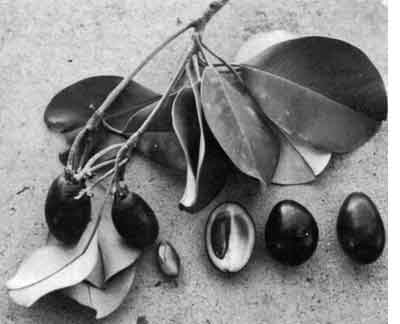
WONGAI - AN AUSTRALIAN FRUIT
SCIENTIFIC NAME: Manilkara kauki
FAMILY: Sapotaceae
 The Wongai (Manilkara kauki) is an Australian native fruit related to the Sapodilla (Manilkara zapota). Trees I have seen with fruit were 6 to 7 m high and apparently fairly old, 20-50 years. I have only seen them on the rocky sea front of some of the islands in the Torres Strait though they also grow in various parts of Cape York Peninsula.
The Wongai (Manilkara kauki) is an Australian native fruit related to the Sapodilla (Manilkara zapota). Trees I have seen with fruit were 6 to 7 m high and apparently fairly old, 20-50 years. I have only seen them on the rocky sea front of some of the islands in the Torres Strait though they also grow in various parts of Cape York Peninsula.
The mature leaves are similar to Sapodilla though more rounded, 4 to 5 cm long, and look like small Tamarillos. The fruit has one or two tan-coloured seeds that are very hard. Flesh recovery on the fruits has been over 60%. The skin can be eaten in well-ripened fruit. As the fruit ripen, they change from hard and green to orange, then red, then soft and purple. At this soft stage they have little to no latex and are pleasant to eat.
The taste may vary, but ones I have eaten could be described as like a 'not-so-sweet' Date or Sapodilla or a very good chinee apple. Fruit can be picked at the hard red stage and left to ripen in 2 - 4 days.
Fruit appear to be favourites of fruit bats, and there are usually plenty of seeds on the ground around the trees. A 1mm round hole may be seen in some seeds. This may be an exit hole caused by an emerging weevil. Seeds can be sorted by placing in water, as the ones that float are often found to be damaged.
Seeds store for a few months and germinate readily. Best germination occurs if the seed case is cracked or cut. Planted 5 to 10mm deep in well-drained potting mix, the seeds should germinate in 2 - 4 weeks in summer. The young plants are slow to grow. A 30cm plant in the first year is good growing.
The wood from an old Wongai tree is very hard and dense. It is used for carving and for making small artefacts such as hair combs. The fruit is very popular with most Islander people both young and old. It is readily available in select spots at the peak of the season - usually May - June.
The Wongai tree has a number of reasons why you should consider it for planting. The tree grows in an attractive shape and is not a large tree. The ripening fruit is very decorative and edible. It is a traditionally favourite tree of the Torres Strait Islanders and Aboriginals. The trees stand up well to the salty SE winds.
There appears to be a fair range in fruit quality and quantity. Careful selection of good trees and planting of that seed will improve the fruit, but even then it may not have commercial appeal other than to shops that specialise Australian foods. The tree may not grow far from the coast and may only like the hot tropics, and even then it appears they may take around 10 years to fruit.
With all this, I still think the Wongai tree is attractive enough in itself to warrant planting, and if you do get it to fruit, you may want the recipe, called Wongai Sabbi Domboy, extracted from the book Torres Strait Cook Book, a Thursday Island State High School Student Publication 1987, and presented in the Recipe Section.
DATE: July 1990
* * * * * * * * * * * * *
